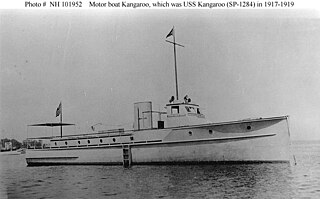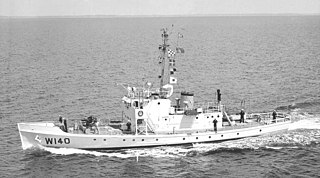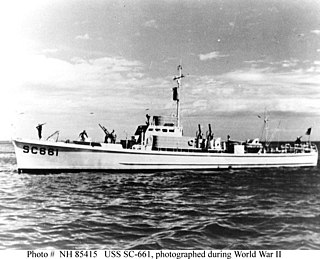
USS Zephyr (PC-8) is a Cyclone-class patrol coastal ship in the United States Navy.

USS Cyclone (PC-1) was the first of the Navy's Cyclone-class coastal patrol ships. As the lead ship of her class, Cyclone served as the test bed for this series of 14 vessels.

USS Tempest (PC-2) is the second of the Cyclone-class of United States Navy coastal patrol ships, named for various weather phenomena. She was transferred to the US Coast Guard as USCGC Tempest (WPC-2), on 1 October 2004, and placed in 'Commission Special' status until December 2005, when she was formally commissioned as a Coast Guard cutter. She was returned to the US Navy on 22 August 2008.

USS Shamal (PC-13) is the thirteenth Cyclone-class patrol ship. Shamal was laid down 23 September 1994 by Bollinger Shipyards, Lockport, Louisiana and launched 3 March 1995. She was commissioned 27 January 1996. Decommissioned by the United States Navy 1 October 2004 and transferred to the United States Coast Guard and recommissioned the USCGC Shamal (WPC-13).

USS Tornado (PC-14) is the fourteenth and last Cyclone-class patrol ships, notable for being the only ship in the class designed with shaping features for signature management. She was laid down by Bollinger Shipyards, Lockport, Louisiana 25 August 1998 and launched 7 June 1999. She was commissioned by the United States Navy 24 June 2000, decommissioned 1 October 2004 and transferred to the United States Coast Guard as USCGC Tornado (WPC-14).

USCGC Icarus (WPC-110) was a steel-hulled, diesel-powered Thetis-class patrol boat of the United States Coast Guard that patrolled the United States East Coast during World War II. In 1942, Icarus sank the German submarine U-352 off the coast of North Carolina and took its survivors into custody as prisoners of war. U-352 was the second World War II U-boat sunk by the United States in American waters, and the first one from which survivors were taken.

USS Yakutat (AVP-32) was a United States Navy Barnegat-class small seaplane tender in commission from 1944 to 1946. Yakutat tended seaplanes in combat areas in the Pacific during the latter stages of World War II. After the war, she was in commission in the United States Coast Guard from 1948 to 1971 as the Coast Guard cutter USCGC Yakutat (WAVP-380), later WHEC-380, seeing service in the Vietnam War during her Coast Guard career. Transferred to South Vietnam in 1971, she was commissioned into the Republic of Vietnam Navy as the frigate RVNS Trần Nhật Duật (HQ-03). When South Vietnam collapsed in 1975 at the end of the Vietnam War, she fled to the Philippines, where the Philippine Navy took custody of her and cannibalized her for spare parts until discarding her in 1982.

USS Unimak (AVP-31) was a United States Navy Barnegat-class small seaplane tender in commission from 1943 to 1946 that saw service in World War II. After the war, she was in commission in the United States Coast Guard as the cutter USCGC Unimak (WAVP-379), later WHEC-379, WTR-379, and again WHEC-379, from 1949 to 1975 and from 1977 to 1988.

USS Seize (ARS-26) was a Diver-class rescue and salvage ship commissioned in the United States Navy during World War II. Her task was to come to the aid of stricken vessels.

USCGC Cuyahoga (WIX-157) was an Active-class patrol boat built in 1927 which saw action in World War II. Cuyahoga sank after a night-time collision in the Chesapeake Bay while on patrol in 1978. She was later raised and re-sunk as an artificial reef off the Virginia coast and is a popular recreational dive site.

USCGC Cape Henlopen was a 95-foot (29 m) type "C" Cape-class cutter constructed at the Coast Guard Yard at Curtis Bay, Maryland in 1958 for use as a law enforcement and search and rescue patrol boat.

The third USS Calypso (AG-35) was launched 6 January 1932 for the United States Coast Guard as USCGC Calypso (WPC-104) by the Bath Iron Works in Bath, Maine. She was initially stationed at San Diego, California and transferred to Baltimore, Maryland in 1938. She was transferred from the Coast Guard to the U.S. Navy on 17 May 1941 and commissioned the same day.

USS Margaret (SP-328) was a menhaden fishing trawler acquired by the U.S. Navy during World War I. She was configured by the Navy as a Section mine sweeper. Post-war she was sold resuming commercial fishing as Margaret. With World War II the vessel was acquired by the U.S. Coast Guard serving from December 1942 to June 1943 as an emergency manned vessel. Margaret resumed menhaden fishing and was shown as active in the U.S. register as late as 1968.

USS Menemsha (AG-39) was a cargo ship acquired by the U.S. Navy during World War II. She was used as a weather-gathering ship, a patrol craft and convoy escort vessel in the North Atlantic Ocean. Although a Navy ship, she was operated by the U.S. Coast Guard, and eventually was transferred to that agency as USCGC Menemsha (WAG-274).

USS Wachapreague (AGP-8) was a motor torpedo boat tender in commission in the United States Navy from 1944 to 1946, seeing service in the latter part of World War II. After her Navy decommissioning, she was in commission in the United States Coast Guard from 1946 to 1972 as the cutter USCGC McCulloch (WAVP-386), later WHEC-386, the fourth ship of the U.S. Coast Guard or its predecessor, the United States Revenue Cutter Service, to bear the name. In 1972 she was transferred to South Vietnam and served in the Republic of Vietnam Navy as the frigate RVNS Ngô Quyền (HQ-17). Upon the collapse of South Vietnam at the end of the Vietnam War in 1975, she fled to the Philippines, and she served in the Philippine Navy from 1977 to 1985 as the frigate RPSGregorio del Pilar (PF-8) and from 1987 to 1990 as BRP Gregorio del Pilar (PF-12).

USCGC Kangaroo, later USCGC AB-6, was United States Coast Guard patrol boat in commission from 1919 to 1932.
USS J. A. Palmer (SP-319), later USS SP-319, was a United States Navy patrol vessel in commission between 1917 and 1919. The vessel was later USCGC Pequot in U.S. Coast Guard service.

The Active-class patrol boat was one of the most useful and long-lasting classes of United States Coast Guard cutters. Of the 35 built in the 1920s, 16 were still in service during the 1960s. The last to be decommissioned from active service was the Morris in 1970; the last in actual service was the Cuyahoga, which sank after an accidental collision in 1978.

MV Cape Pine is a charter boat operated by the Maritime Heritage Society of Vancouver. She began life as USS SC-715, a SC-497-class submarine chaser of the United States Navy. She was later transferred to the United States Coast Guard and served under the name USCGC Air Killdeer. Finally sold into mercantile service, as the Cape Pine, she worked as a high-endurance fish packer in the fisheries of the Canadian coast, and was then sold to the Maritime Heritage Society of Vancouver.




















